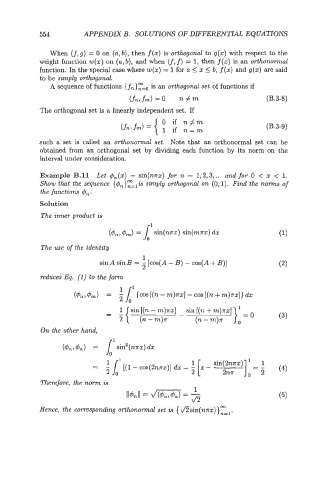Page 574 - Modelling in Transport Phenomena A Conceptual Approach
P. 574
554 APPENDIX B. SOLUTIONS OF DWFERENTIAL EQUATIONS
When { f, g) = 0 on (a, b), then f (z) is orthogonal to g(z) with respect to the
weight function w(x) on (a,b), and when (f, f) = 1, then f(x) is an orthonomal
function. In the special case where w(z) = 1 for a 5 x 5 b, f (x) and g(x) are said
to be simply orthogonal.
A sequence of functions { fn}z=o an orthogonal set of functions if
is
(fn, fm) = 0 n # m (B.3-8)
The orthogonal set is a linearly independent set. If
0 if n#m
(fn, fm) = { 1 if n=m (B.3-9)
such a set is called an orthonormal set. Note that an orthonormal set can be
obtained from an orthogonal set by dividing each function by its norm on the
interval under consideration.
Example B.ll Let &(x) = sin(nm) for n = 1,2,3, ... and for 0 < z < 1.
Show that the sequence {+,}:=,is simply orthogonal on (0,l). Find the noms of
the functions q5n.
Solution
The inner product is
The we of the identity
1
sinA sinB = - [cos(A - B) - cos(A + B)]
2
reduces Eq. (1) to the form
1 ,
(&, 4,) = 5 1 {cos [(n - m)?rx] - cos [(n + m)?rx]} dx
0
1 sin [(n - m)7rx] sin [(n + m)ax]
-
}l =O
= I( (n-m)?r (n-mb 0 (3)
On the other hand,
1
(+,,4,) = J sin2(nm)dz
0
1
[(l - cos(2n?rz)] dx = (4)
2
Therefore, the norm is
Hence, the corresponding orthonormal set is { \/Zsin(nxx)}~==,.

